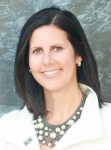Robert Krell, left, and Elie Wiesel. (photo from Robert Krell)
I met Prof. Elie Wiesel in 1978. I was 38 years old. He was 49. Elie, as he insisted I call him, came to Vancouver to speak at a commemorative event. It was for Yom Hashoah, the day of Holocaust Remembrance.
He arrived Friday afternoon and I fetched him at the airport and brought him to our home for a few moments pre-Shabbat and then to his hotel. He had agreed to a press conference on Saturday morning stipulating only that no microphone be used. Elie was observant.
I moderated that morning. He was engaging, handled difficult and peculiar questions equally graciously, and made a deep and lasting impression on the journalists and religious leaders who attended. I learned that morning that his book, Night, a slim 120 pages, had once been nearly a thousand pages written in Yiddish and published in Argentina. How had he reduced it to its present size? By eliminating every paragraph without which the book would not lose its essence, and then by eliminating every sentence in those paragraphs that was not needed to sustain its narrative. Ever since, I have tried to practise that in my talks and writings.
Elie asked me to visit at the hotel on Sunday for breakfast and we ended up talking all day. That evening, he spoke to an audience of 500. I had the honor of introducing him. I used two minutes. How long does one need to introduce Wiesel? He was known to all, even though he had not yet received the Nobel Peace Prize; that was to come in 1986. His lecture that evening was astonishing. One could listen to him forever, one of the few speakers in the world who commands attention and seldom, if ever, loses his audience.
We remained friends. He was the kindest, gentlest, wisest person in my life. And he always made time for me although he was also the busiest and most prevailed upon person imaginable.
So, I took it upon myself to do two things. One was to call him from time to time and briefly visit when I was in New York. Famous people sometimes have no one who inquires as to their own lives. I did not ask him for anything unless the idea began with him. No demands, requests, or favors. The other was to assist wherever I could with whatever little I could do. For example, he asked whether I could arrange for him to be in touch with Rudolf Vrba, one of only four or five escapees from Auschwitz and the author of the Vrba-Wetzler Report (Auschwitz Protocols) warning of the imminent deportation of Hungarian Jews in 1944.
Vrba lived in Vancouver and I knew him well. Elie and Rudi subsequently corresponded for years and I can only guess that some of it concerned the fact that the Wiesel family was not informed by those who received the report in Hungary when there was still a chance to flee into the nearby Carpathian Mountains. Did they ever meet? I offered Elie the opportunity. His response, “I do not think I can look into his eyes.”
One time, when in New York, I received Elie’s return call. Yes, he had time for me to have a brief visit on Monday morning. I went to his home and we caught up for perhaps a half hour. During that time, he excused himself only once, to take a call from the White House. Presidents, secretaries of state, governors and senators, all sought his counsel. He often flew at short notice to speak, to warn, in the midst of various crises around the world.
It was close to Passover. He asked who was traveling with me and I told him, my wife Marilyn and our oldest daughter and granddaughter. Elie was upset not to greet them and he insisted we all visit the next Thursday so he could personally wish them a happy Pesach. How he made time in his wildly busy schedule, I will never understand.
I saw Elie speak in Israel at the 1981 World Gathering of Jewish Holocaust Survivors at Lohamei HaGeta’ot (the Kibbutz of the Ghetto Fighters) and at the closing ceremonies with then-prime minister Menachem Begin. While in Los
Angeles in 1982, I heard him speak at Cedars-Sinai Hospital on “the Holocaust patient” and on “talmudic tales” at UCLA Hillel House. Spellbinding.
For the very first International Conference of Child Survivors and Their Families – the 1991 Hidden Child Foundation/Anti-Defamation League conference – the New York-based committee asked if I could convince Elie to speak. Since Elie seldom said no if he was able to attend, wherever in the world he was needed, this request for my involvement was puzzling. After all, this was New York, his home and the site of the gathering. But he had declined. My guess is that the situation had become complicated by competing factions.
I called him and reminded him that this was “the gathering of the children.” Where else would he want to be? He graciously agreed to give the closing address. I introduced him on the closing night and wondered out loud how it was possible that I had heard him lecture at Yale, in Israel, New York and Los Angeles. Somehow, wherever he was, I found him. I must be his groupie! I certainly never missed an opportunity to hear him and to learn from him.
In 1998, in New York, Elie presented me with the Elie Wiesel Holocaust Remembrance Medal for my work in Holocaust education, my psychiatric contributions to the care of Holocaust survivors and the founding of the Vancouver Holocaust Education Centre. Elie had visited the VHEC and served on its international advisory council along with Irwin Cotler, Yaffa Eliach and Sir Martin Gilbert. My family was there and my children all came to know him better. His loving presence is seared into their memories. Children, for him, were like a magnet. All who wrote to him received a personal response. How he managed this, in between teaching at Boston University, speaking around the world and publishing at least one book every year, I do not understand. But that is what he did.
In 2008, I went to Boston to celebrate his 80th birthday, which consisted of a three-day Festschrift devoted to his scholarship and writings, as well as a tribute concert.
Although surrounded by his friends and fellow scholars, I found him sitting alone in the front row and joined him. At one point, I turned to him, “Elie, what is it like to hear all these scholars speak about your contributions all day long?” His response, “I am a good listener.” And, indeed, he was. He listened attentively, to individuals and to humanity.
I nominated Elie for an honorary doctorate from the University of British Columbia and, although he was still recovering from open heart surgery (and wrote a book Open Heart), he traveled to attend the 2012 ceremony and to participate in An Evening with Elie Wiesel, held at the Orpheum theatre, attended by some 3,000 people. Our cab driver said, “Oh, look, Elie Wiesel is speaking.”
As the interviewer for the evening’s proceedings, I asked questions, some “naïve,” as in “Why remember such awful events?” referring to the Shoah.
Elie’s response: “How can you not? Memory is part of who you are, your identity. I have so many wonderful memories of my family and being in shul and it’s all I have now of my family except my two surviving sisters, of whom one has since passed on. Without memory, who would I be? The moments are so important.”
“Elie,” I asked, “you were asked to be the president of Israel. Can you tell us about this?” He answered that the thought had tormented him. How could he turn down the highest honor that could ever be bestowed upon him? He felt he was letting down the state of Israel that wanted him and his leadership. But, he explained, he was without political experience and all he really has are words which, as a politician, would no longer be his. “And besides,” he joked, “my wife would have divorced me.”
“How do you choose the language in which you write?” (Elie speaks Hungarian, Romanian, Yiddish, Hebrew, French and English.) “I prefer the eloquence of French, which is the easiest for me. And, sometimes, my choice is determined by what I am writing about. And I like to write to classical music, preferably a quartet, as an orchestra is too distracting.”
“What message would you send to our young people here tonight?” His response, “Your life is not measured in time and years. It is a collection of moments. You will look back and have so many moments in time that remain fresh, memorable and meaningful. I would tell all of you young people in the audience to enjoy all these moments in time. Being here in Vancouver this weekend has been one of those moments for me.”
With his passing, I shall be without more such moments with him. His death leaves an enormous void, for his moral strength and inspiration will be missing from all who benefited. We must resolve to step up and commit to continuing to learn from and emulate this remarkable human being who returned from the depths of despair and loss to provide a measure of hope.
I urge you to read Night and Elie’s brilliant memoir in two parts All Rivers Run to the Sea and And the Sea is Never Full. Having absorbed at least these books, you may then reflect upon, and hopefully act upon, the lessons learned. They will last you a lifetime.
Dr. Robert Krell is professor emeritus, department of psychiatry, University of British Columbia, distinguished life fellow of the American Psychiatric Association and founding president of the Vancouver Holocaust Education Centre, in whose newsletter, Zachor, this article has also been published.

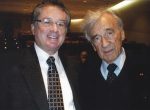
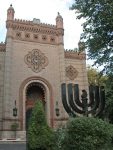
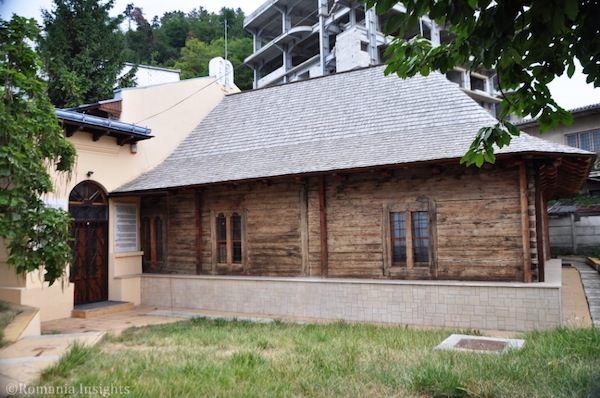

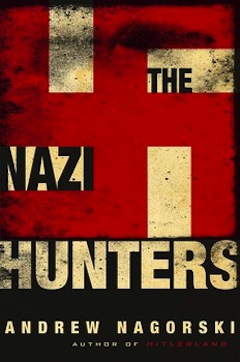 The story of Eichmann’s capture, extra-judicial extradition to Israel, trial and execution is retold in The Nazi Hunters, a book by author and former Newsweek journalist Andrew Nagroski, who will be in Vancouver this fall as part of the Cherie Smith JCC Jewish Book Festival.
The story of Eichmann’s capture, extra-judicial extradition to Israel, trial and execution is retold in The Nazi Hunters, a book by author and former Newsweek journalist Andrew Nagroski, who will be in Vancouver this fall as part of the Cherie Smith JCC Jewish Book Festival.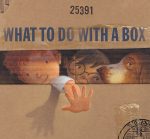
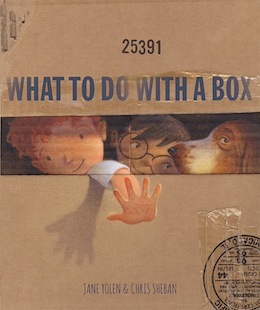 The beautifully and creatively illustrated What to do with a Box (Creative Editions, 2016) features the rhythmic writing of Jane Yolen and the inspired art of Chris Sheban. The book is a tribute to the power of the imagination – a way to impart to the younger set that fun doesn’t necessarily need batteries. It’s also a reminder to parents that expensive toys aren’t at the root of what makes playtime enjoyable, and they may even be enticed to join their kids in a cardboard box adventure – if they’re invited to come along, that is.
The beautifully and creatively illustrated What to do with a Box (Creative Editions, 2016) features the rhythmic writing of Jane Yolen and the inspired art of Chris Sheban. The book is a tribute to the power of the imagination – a way to impart to the younger set that fun doesn’t necessarily need batteries. It’s also a reminder to parents that expensive toys aren’t at the root of what makes playtime enjoyable, and they may even be enticed to join their kids in a cardboard box adventure – if they’re invited to come along, that is.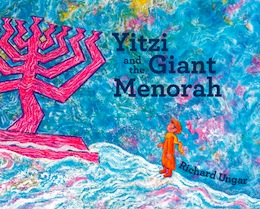 For slightly older readers (or listeners), Richard Unger has written and illustrated a more traditional story with Chagallesque art, Yitzi and the Giant Menorah (Penguin Random House, 2016). It is a picture book, but with a substantive amount of text on each page. It, too, is beautifully and creatively put together, with most of the text printed on a plain page that includes a black-and-white sketch that doesn’t overlap it in any way, making the reading easier. More importantly, it leaves most of the colorful, vibrant and expressive artwork on the opposite page free from writing. At the end of the book is the brief story of Chanukah.
For slightly older readers (or listeners), Richard Unger has written and illustrated a more traditional story with Chagallesque art, Yitzi and the Giant Menorah (Penguin Random House, 2016). It is a picture book, but with a substantive amount of text on each page. It, too, is beautifully and creatively put together, with most of the text printed on a plain page that includes a black-and-white sketch that doesn’t overlap it in any way, making the reading easier. More importantly, it leaves most of the colorful, vibrant and expressive artwork on the opposite page free from writing. At the end of the book is the brief story of Chanukah.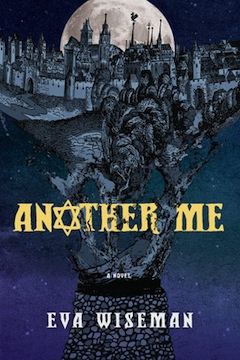 Eva Wiseman’s Another Me (Tundra Books, 2016) is set in the mid-1300s in Strasbourg, France. It starts with the main character’s death at the hands of the men poisoning the town’s water – an act the Jews were accused of committing not only in Strasbourg, but other cities in Europe, as well. It was thought that poisoned water was causing the plague and, since fewer Jews were dying, the rumors began that they were causing the illness. In reality, Jews were also dying, but in fewer numbers because Jewish law required much more handwashing than was customary in medieval times.
Eva Wiseman’s Another Me (Tundra Books, 2016) is set in the mid-1300s in Strasbourg, France. It starts with the main character’s death at the hands of the men poisoning the town’s water – an act the Jews were accused of committing not only in Strasbourg, but other cities in Europe, as well. It was thought that poisoned water was causing the plague and, since fewer Jews were dying, the rumors began that they were causing the illness. In reality, Jews were also dying, but in fewer numbers because Jewish law required much more handwashing than was customary in medieval times.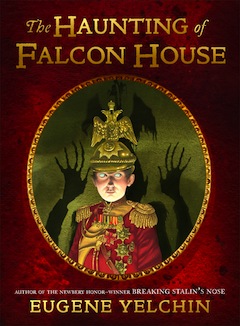 Magic – or, at least, ghosts – also informs the storytelling in Eugene Yelchin’s The Haunting of Falcon House (Henry Holt and Co., 2016).
Magic – or, at least, ghosts – also informs the storytelling in Eugene Yelchin’s The Haunting of Falcon House (Henry Holt and Co., 2016). Jane Yolen’s Briar Rose: A Novel of the Holocaust (Tor Teen, 2016) is also a retelling – an adaptation of Sleeping Beauty. And, it is a reissue, having originally been published almost 15 years ago in a series created by Terri Windling, which comprised novels by various authors that reinterpreted classic fairy tales.
Jane Yolen’s Briar Rose: A Novel of the Holocaust (Tor Teen, 2016) is also a retelling – an adaptation of Sleeping Beauty. And, it is a reissue, having originally been published almost 15 years ago in a series created by Terri Windling, which comprised novels by various authors that reinterpreted classic fairy tales.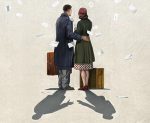
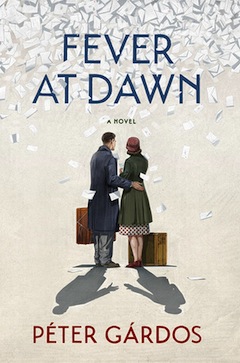
 Two-Gun & Sun (Caitlin Press Inc., 2015) might also make a good film. It brings to mind Joss Whedon’s Firefly, mixing science fiction (specifically steampunk) with opera’s larger-than-life and often unbelievable drama with history. It’s a very stylized novel, which, more than other books, means that it will be loved by some readers, and not so much by others.
Two-Gun & Sun (Caitlin Press Inc., 2015) might also make a good film. It brings to mind Joss Whedon’s Firefly, mixing science fiction (specifically steampunk) with opera’s larger-than-life and often unbelievable drama with history. It’s a very stylized novel, which, more than other books, means that it will be loved by some readers, and not so much by others.

